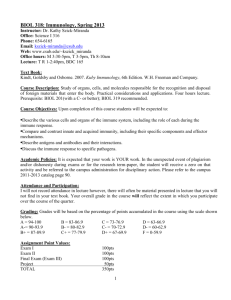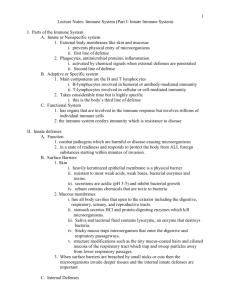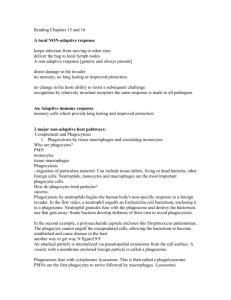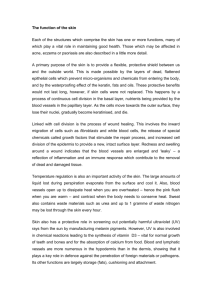YouTube Nuts and Bolts of Immunity Outline
advertisement
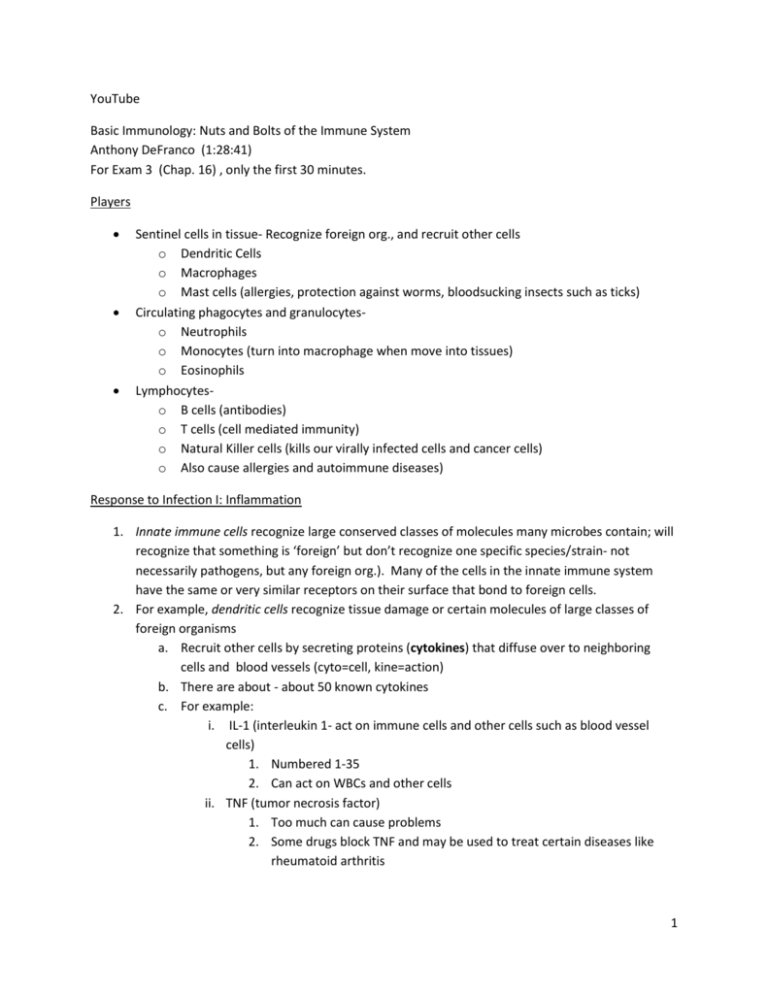
YouTube Basic Immunology: Nuts and Bolts of the Immune System Anthony DeFranco (1:28:41) For Exam 3 (Chap. 16) , only the first 30 minutes. Players Sentinel cells in tissue- Recognize foreign org., and recruit other cells o Dendritic Cells o Macrophages o Mast cells (allergies, protection against worms, bloodsucking insects such as ticks) Circulating phagocytes and granulocyteso Neutrophils o Monocytes (turn into macrophage when move into tissues) o Eosinophils Lymphocyteso B cells (antibodies) o T cells (cell mediated immunity) o Natural Killer cells (kills our virally infected cells and cancer cells) o Also cause allergies and autoimmune diseases) Response to Infection I: Inflammation 1. Innate immune cells recognize large conserved classes of molecules many microbes contain; will recognize that something is ‘foreign’ but don’t recognize one specific species/strain- not necessarily pathogens, but any foreign org.). Many of the cells in the innate immune system have the same or very similar receptors on their surface that bond to foreign cells. 2. For example, dendritic cells recognize tissue damage or certain molecules of large classes of foreign organisms a. Recruit other cells by secreting proteins (cytokines) that diffuse over to neighboring cells and blood vessels (cyto=cell, kine=action) b. There are about - about 50 known cytokines c. For example: i. IL-1 (interleukin 1- act on immune cells and other cells such as blood vessel cells) 1. Numbered 1-35 2. Can act on WBCs and other cells ii. TNF (tumor necrosis factor) 1. Too much can cause problems 2. Some drugs block TNF and may be used to treat certain diseases like rheumatoid arthritis 1 3. Blood vessels respond to cytokines in the area of damage a. At the site of inflammation, cytokines alter cellular adhesion molecules on cells lining blood vessels, i.e., put adhesion (sticky) molecules (chemokines- specific type determine what type of white blood cell sticks and comes in) on the inner surface of the blood vessel walls (endothelium=lining of blood vessels). Cytokines causing this sticking response (margination- see text) also occurs in red bone marrow and causes release of phagocytes into circulation when they are needed. b. The circulating immune cells (phagocytes- neutrophils are the first to respond, monocytes next which become macrophages) i. Adhere to the inside walls of the blood vessels ii. Then they squeeze between the endothelial cells of the blood vessels and move out of the blood vessels and into the damaged/infected area (diapedesis‘amoeboid movement) iii. Phagocytosis occurs iv. Neutrophils come in first, die off fast, must be continually replenished (pus mostly dead neutrophils) 1. Can also cause damage to tissue v. Monocytes comes in after the neutrophils, develop into macrophages, and clean up dead neutrophils, dead tissues, etc. c. Blood vessels also allow fluid from the blood into the damaged/infected area providing soluble components such as antibodies, clotting proteins (text) which wall off infection (pus text) Killing of Microbes by Phagocytes Neutrophils and Macrophages directly recognize characteristic features on many microbes’ cell surfaces and can ‘eat’ them (phagocytosis) and kill them once inside Soluble immune components (innate components and antibodies) can coat the microbe which allows phagocytes to eat them voraciously Many microbes that can cause disease can do so because they are able to evade our immune systems: phagocytes can’t ingest them or can’t kill them once inside For Exam 3, only up to here. The following is the first part for Exam 4. Adaptive Immunity Our Most Powerful Defense (Third Line of Defense) B cells (create antibodies) and T cells The Adaptive Immune System learns from previous experience- can recognize them quickly upon reinfection These millions or billions of different B and T cells have different receptors that recognize and bind to specific microbes o How can we produce so many different B and T cells? 2 o Different segments of several genes in the DNA responsible for making the receptors on the surface of the B and T cells (the receptors that bond to the microbe) are randomly chosen. These segments of the DNA are randomly put together differently in each B and T cell during differentiation (it is pure chance in any one B or T cell which DNA segments are used). This happens while the B and T cells are formed before they are released. The body doesn’t know what microbe they will bond to, but there are so many different types released that, if all is functioning correctly, there will be so many different ones in the body that anything that infects us will be recognized. These receptors are highly specific and only bond to a specific molecule on a specific pathogen. The part of the microbe that the B cell or T cell receptor bonds to is called the antigen. 3 YouTube Nuts and Bolts of Immunity 1. List 3 ‘Sentinal Cells’ in the innate immune system. 2. What is meant by sentinel cells? 3. What is meant by ‘circulating’ cells in the innate immune system? 4. What are the lymphocytes? 5. What are the interleukins and TNF? When are they produced? What do they do? 6. How do blood vessels respond to cytokines? 4 7. Describe the role of neutrophils and macrophages. 8. How do antibodies and soluble blood fluid components help phagocytosis? 9. What is margination? 10.How do neutrophils get out of the blood vessels? 11.Is inflammation beneficial? Explain. 5 12.List the steps that occur in the inflammatory response starting with the sentinel cells 6
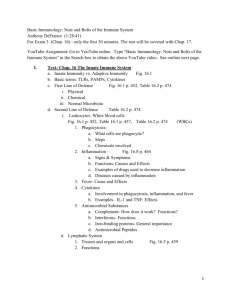
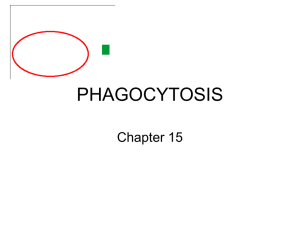
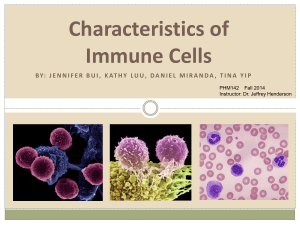
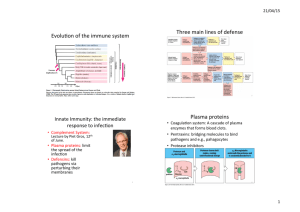
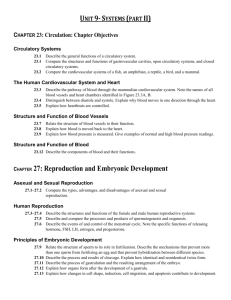
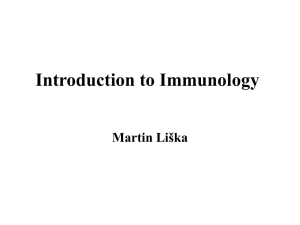
![Immune Sys Quiz[1] - kyoussef-mci](http://s3.studylib.net/store/data/006621981_1-02033c62cab9330a6e1312a8f53a74c4-300x300.png)

